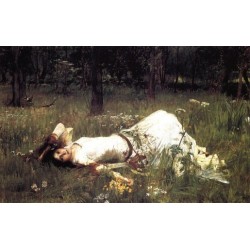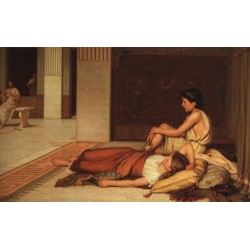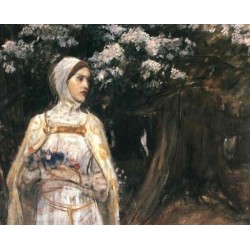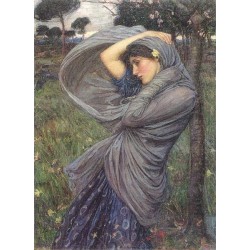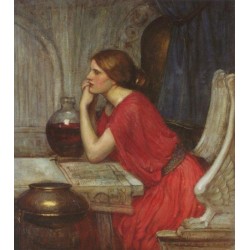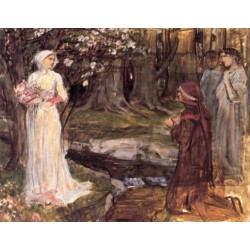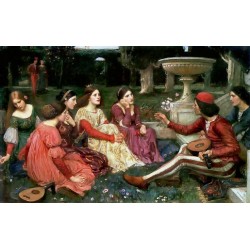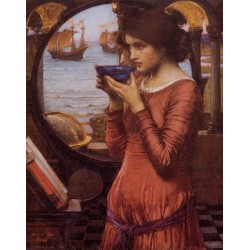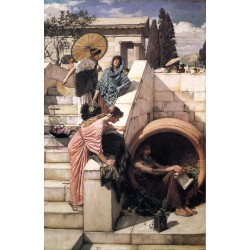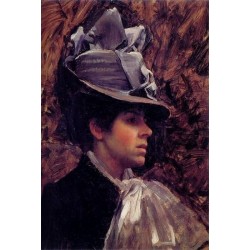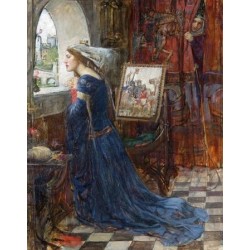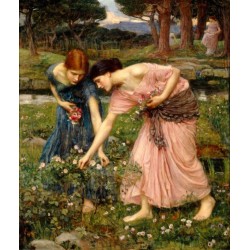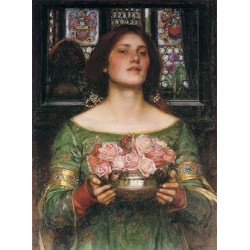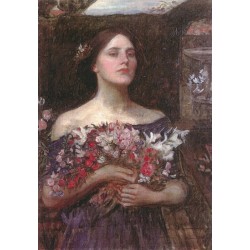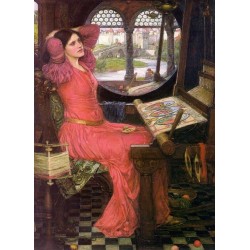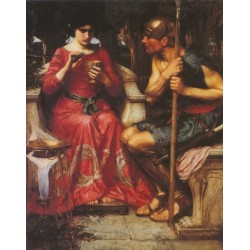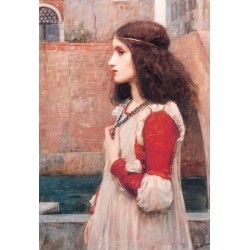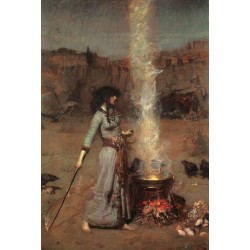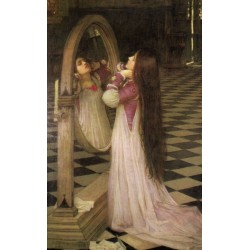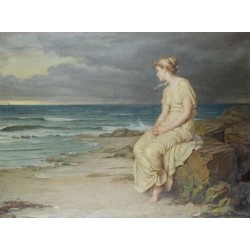Waterhouse
Unveiling the Timeless Beauty of Waterhouse Paintings: A Dive into the World of Art
Step into the enchanting world of art as we dive deep into the timeless beauty of Waterhouse paintings. With every brushstroke, these masterpieces capture the essence of emotion and transport us to a realm filled with passion, mystery, and ethereal beauty. Renowned for his ability to infuse his artworks with a...
Unveiling the Timeless Beauty of Waterhouse Paintings: A Dive into the World of Art
Step into the enchanting world of art as we dive deep into the timeless beauty of Waterhouse paintings. With every brushstroke, these masterpieces capture the essence of emotion and transport us to a realm filled with passion, mystery, and ethereal beauty. Renowned for his ability to infuse his artworks with a sense of romanticism, John William Waterhouse has left an indelible mark on the art world. Through his incredible talent, he has brought to life mythical creatures, captivating heroines, and breathtaking landscapes, all bathed in a delicate play of light and shadow. Join us on this journey as we unravel the stories behind his most iconic paintings, delving into the symbolism and narratives that make them so captivating. Whether you're an art enthusiast or simply curious about the power of visual storytelling, this exploration of Waterhouse's art is sure to leave you inspired and in awe of his enduring legacy. Get ready to immerse yourself in the mesmerizing world of Waterhouse's art, where beauty knows no bounds and imagination takes flight.
The Life and Influences of John William Waterhouse
John William Waterhouse was born in Rome in 1849 to English parents. His early exposure to the vibrant art scene in Italy sparked his passion for painting. Waterhouse's family later moved to London, where he studied at the Royal Academy of Arts. It was during this time that he was heavily influenced by the works of the Pre-Raphaelite Brotherhood, a group of artists who sought to revive the detailed and vibrant aesthetic of early Renaissance art.
Waterhouse's paintings often depicted scenes from mythology, literature, and history, showcasing his deep appreciation for the classics. He was particularly drawn to the works of Shakespeare, Tennyson, and Homer, finding inspiration in their timeless stories of love, tragedy, and heroism. This fascination with storytelling is evident in his art, as each painting tells a captivating narrative through its composition, colors, and symbolism.
Waterhouse's unique style combined the meticulous attention to detail of the Pre-Raphaelite movement with his own romantic flair. His use of vibrant colors, intricate patterns, and soft brushstrokes created a dreamlike quality that enhanced the emotional impact of his paintings. This distinct style, coupled with his ability to capture the human form with grace and sensitivity, established Waterhouse as a master painter.
The Themes and Symbolism in Waterhouse's Paintings
Waterhouse's paintings are rich with symbolism, inviting viewers to delve deeper into their meanings. One recurring theme in his art is the exploration of feminine beauty and its connection to nature. His depictions of ethereal women adorned in flowing garments and surrounded by lush landscapes evoke a sense of harmony between humanity and the natural world. These women often embody mythical figures or characters from literature, representing ideals of love, beauty, and strength.
Waterhouse also explored themes of love and desire in his paintings, often depicting passionate encounters between lovers or unrequited longing. His ability to capture the complexities of human emotion is evident in the expressions and body language of his subjects. Whether it's the yearning gaze of a lovestruck maiden or the pained expression of a spurned lover, Waterhouse's paintings evoke a deep sense of empathy and connection.
Another significant element in Waterhouse's art is the use of water as a symbolic motif. Water, with its reflective and transformative qualities, serves as a metaphor for the ever-changing nature of life and emotions. In many of his paintings, water acts as a boundary between different realms, representing the threshold between the conscious and the subconscious, the mortal and the divine. The interplay of light and water in his artworks creates a sense of enchantment and mystery, drawing viewers into a world where reality and imagination merge.
The Pre-Raphaelite Movement and Waterhouse's Place in Art History
To truly appreciate Waterhouse's art, it's important to understand his place within the context of the Pre-Raphaelite movement. The Pre-Raphaelite Brotherhood, formed in 1848, sought to challenge the prevailing artistic conventions of the time and return to the detailed and vibrant style of early Renaissance art. Led by artists such as Dante Gabriel Rossetti and John Everett Millais, the movement emphasized meticulous attention to detail, vibrant colors, and a focus on literary and mythological subjects.
While Waterhouse was not a member of the original Brotherhood, his art was heavily influenced by their ideals and aesthetics. He shared their love for storytelling and their fascination with mythology and history. Waterhouse's paintings often featured the same attention to detail and vibrant color palette that characterized the works of the Pre-Raphaelites.
Waterhouse's association with the Pre-Raphaelite movement helped solidify his place in art history. His art bridged the gap between the Pre-Raphaelite Brotherhood and the later Symbolist movement, which sought to explore the deeper meanings and emotions behind art. Waterhouse's paintings, with their intricate symbolism and evocative narratives, exemplified the ideals of the Symbolists, making him a significant figure in the transition from one movement to another.
Analyzing Waterhouse's Technique and Style
Waterhouse's technique and style are a testament to his mastery as a painter. His meticulous attention to detail is evident in every brushstroke, as he painstakingly captures the intricacies of fabric, hair, and skin. The vibrant colors he employed, often juxtaposed with soft, diffused lighting, create a sense of depth and dimensionality in his paintings.
One notable aspect of Waterhouse's technique is his use of glazes, a method employed by many Renaissance painters. By applying multiple thin layers of translucent paint, he was able to achieve a luminous effect, particularly in his depictions of water and skin. This technique adds a sense of ethereality to his art, enhancing the dreamlike quality for which he is known.
Waterhouse's skill in capturing the human form is also remarkable. His figures, whether male or female, possess a grace and sensuality that is both captivating and realistic. The attention to anatomical accuracy, coupled with his ability to convey emotion through facial expressions and body language, breathes life into his paintings and draws viewers into the narratives he creates.
Popular Waterhouse Paintings and Their Meanings
Waterhouse's body of work is vast and varied, encompassing a wide range of themes and subjects. Several paintings have become iconic symbols of his artistry and continue to captivate audiences to this day. Let's explore some of Waterhouse's most popular paintings and the meanings behind them.
1. "The Lady of Shalott" (1888): Based on Alfred Lord Tennyson's poem of the same name, this painting depicts the tragic story of a cursed lady who is confined to a tower. Waterhouse's portrayal of the Lady of Shalott captures her isolation and longing for freedom. The vibrant colors and intricate details in the tapestry surrounding her symbolize the rich inner world she creates through her art.
2. "The Siren" (1900): In this painting, Waterhouse depicts a seductive siren perched on a rock, luring sailors to their doom with her enchanting song. The siren's gaze and alluring pose convey both power and vulnerability, reflecting the complex nature of desire and temptation.
3. "Hylas and the Nymphs" (1896): Inspired by Greek mythology, this painting portrays Hylas, a young warrior, being enticed by nymphs into the water. The composition and lighting in this artwork create a sense of otherworldly beauty, while also alluding to the danger and temptation that lie beneath the surface.
4. "Ophelia" (1894): Waterhouse's interpretation of Shakespeare's tragic character Ophelia showcases his ability to capture the delicate balance between beauty and melancholy. The floating flowers and serene expression on Ophelia's face serve as symbols of her untimely demise and the fleeting nature of life.
Waterhouse's Legacy and Impact on Contemporary Art
Waterhouse's art continues to inspire and influence contemporary artists, as his timeless themes and evocative style resonate with audiences across generations. His ability to merge storytelling with visual aesthetics has had a profound impact on the world of art and visual media.
In the realm of contemporary art, many artists draw inspiration from Waterhouse's use of symbolism and narrative. They explore similar themes of femininity, mythology, and the interplay between reality and imagination. Waterhouse's legacy can be seen in the works of artists such as Mark Ryden, Audrey Kawasaki, and Ray Caesar, who incorporate elements of fantasy and storytelling into their art.
Waterhouse's influence extends beyond the art world and into popular culture. His paintings have been featured in films, music videos, and literature, further cementing his status as a cultural icon. The enduring appeal of his art lies in its ability to evoke emotions and transport viewers to a world of beauty and wonder.
Exhibitions and Museums Featuring Waterhouse's Artworks
Waterhouse's art can be experienced firsthand through exhibitions and museums dedicated to his work. These venues provide a unique opportunity to immerse oneself in the mesmerizing world he created and gain a deeper understanding of his artistic vision.
The Tate Britain in London houses an extensive collection of Waterhouse's paintings, including some of his most famous works. The museum regularly organizes exhibitions that showcase his art alongside that of other Pre-Raphaelite artists, offering a comprehensive exploration of the movement.
In addition to the Tate Britain, the Royal Academy of Arts and the Victoria and Albert Museum also feature Waterhouse's art in their collections. These institutions provide a valuable platform for art enthusiasts to appreciate and study his paintings in a curated setting.
Collecting Waterhouse Paintings: Tips for Art Enthusiasts
For art enthusiasts and collectors, owning a Waterhouse painting is a highly sought-after dream. However, given the rarity and value of his artworks, collecting Waterhouse paintings can be a challenging endeavor. Here are some tips for those interested in starting their own Waterhouse collection:
1. Research and Educate Yourself: Familiarize yourself with Waterhouse's body of work, his artistic style, and the historical context in which he created. This knowledge will help you make informed decisions when acquiring his paintings.
2. Seek Expert Advice: Consult with art experts, dealers, and auction houses specializing in Pre-Raphaelite art. Their expertise can guide you in identifying authentic Waterhouse paintings and determining their value.
3. Attend Auctions and Art Fairs: Keep an eye out for auction houses and art fairs that feature Waterhouse paintings. These events provide an opportunity to view and potentially acquire his artworks directly from sellers or collectors.
4. Consider Reproductions and Prints: If owning an original Waterhouse painting is not feasible, consider collecting high-quality reproductions or limited-edition prints. These can still bring the beauty and essence of his art into your home.
Conclusion: The Timeless Beauty and Enduring Appeal of Waterhouse's Art
John William Waterhouse's art is a testament to the power of visual storytelling and the enduring beauty of the human imagination. His paintings continue to captivate audiences with their ethereal beauty, intricate symbolism, and evocative narratives. From mythical creatures to captivating heroines, Waterhouse's artworks transport us to a world where passion, mystery, and beauty reign supreme.
Through his unique style and masterful technique, Waterhouse has left an indelible mark on the art world. His paintings not only reflect his own artistic vision but also serve as a bridge between different artistic movements and generations. Waterhouse's legacy lives on in the works of contemporary artists and in the hearts of art enthusiasts around the world.
So, step into the mesmerizing world of Waterhouse's art, where beauty knows no bounds and imagination takes flight. Explore the stories behind his iconic paintings, unravel the symbolism and narratives that make them so captivating, and immerse yourself in the timeless beauty that continues to inspire and awe.



